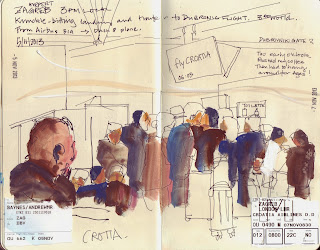Out through Banbury, past it’s cross, which now sits astride
a roundabout.
Out west across an Oxfordshire top road, up and down through
brown fields and golden trees. All polished by the November sun, low across the
landscape.
Onward to Lower Brailes to meet up with good colleagues Wayne and Mark.
With work behind us they escort me to St Georges Church,
featured in Jenkins’ 1000 Best Churches. We are as one with its loveliness.
The pale gold gingerbread church tower reach up through the
trees, visible for miles.
Higgledy Piggledy gravestones amongst unrestrained grass
Inside all is huge and calm and once a garrison for Royalist
troops.
The Victorian restorers have been a work with little damage
done.
This is the ‘cathedral of the Feldon, we are in
Warwickshire.
Our investigation and my drawing of the Decorated font,
complete we repair to The Gate public house in Upper Brailes. A sup of sound
Hook Norton Ale, our backs to a warming fire, we contemplate richness of this
world.
















